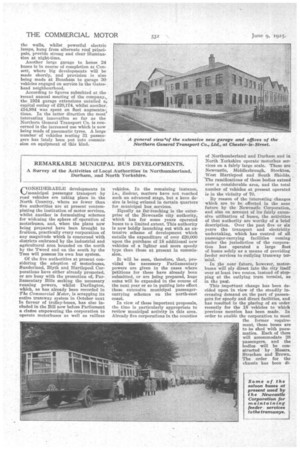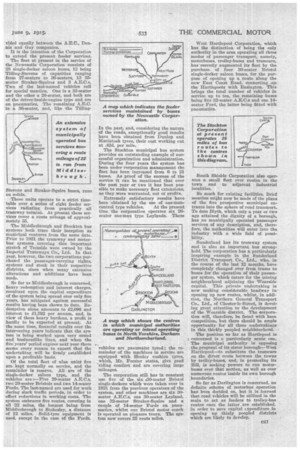REMARKABLE MUNICIPAL BUS DEVELOPMENTS.
Page 24

Page 25

If you've noticed an error in this article please click here to report it so we can fix it.
A Survey of the Activities of Local Authorities in Northumberland, Durham, and North Yorkshire.
CONSIDERABLE developments in municipal passenger transport by road vehicles are taking place in the North Country, where no fewer than five authorities are at present contemplating the institution of motor services, whilst another is formulating schemes for widening the sphere of operation of motorbuses, and, when the plans now being prepared have been brought to fruition, practically every corporation of any magnitude which is concerned with districts embraced by the industrial and agricultural area bounded on the north by the Tweed and on the south by the Tees will possess its own bus system.
Of the five authorities at present considering the adoption of inotorbuses, Sunderland, Blyth and Hartlepool Corporations have either already promoted, or are busy with the promotion of, Parliamentary Bills seeking the necessary running powers, whilst Darlington, which, as has already been recorded in The Commercial Motor, is scrapping its entire tramway system in October next In favour of trolley-buses, has also included in the Bill now before Parliament a clatise empowering the corporation to operate motorbuses as well as railless vehicles. In the remaining instance, i.e. Itedcar, matters have not reached such an advanced stage, but a keeu desire is being evinced in certain quarters for municipal bus services.
Equally as far-reaching is the enterprise of the Newcastle city authority, which has for some years operated buses to a limited extent. This authority is now boldly launching out with an extensive scheme of development which entails the expenditure of over 120,000 upon the purchase of 18 additional new vehicles of a lighter and more speedy type than those at present in commission.
It will be seen, therefore, that, provided the necessary Parliamentary powers are given in the cases where petitions for these have already been submitted, or are being prepared, huge elms will be expended in the course of the next year or so in putting into effect these extensive municipal passengercarrying schemes on the north-east coast.
In view of these important proposals, the time is particularly appropriate to review municipal activity in this area. Already five corporations in the counties of Northumberland and Durham and in North Yorkshire operate motorbus services on a fairly large scale. These are Newcastle, Middlesbrough, Stockton, West Hartlepool and South Shields. The ramifications of these bodies extend over a considerable area, and the total number of vehicles at present operated is in the vicinity of 70.
By reason of the interesting changes which are to be effected in the near future by the Newcastle Corporation, and also on account of its fairly extensive utilization of buses, the activities of that authority are worthy of a brief description. Over the past five or six years the transport and electricity undertaking, which has control of all passenger-carrying facilities coming under the jurisdiction of the corporation has operated a large fleet of buses solely as a means of providing feeder services to outlying tramway termini.
In the near future, however, motorbuses will ply direct into the city itself over at least two routes, instead of stopping at the outlying tram termini, as in the past.
This important change has been decided upon in view of the steadily increasing demand on the part of passengers for speedy and direct facilities, and has resulted in the placing of an order recently for the 18 vehicles to which previous mention has been made. In order to enable the corporation to meet the former requirement, these buses are to be shod with pneumatics. Each of them_ will accommodate 28 Passenger% and the bodies will be constructed by Messrs. Strachan and Brown. The order for the chassis has been di vided equally between the A.E.C., Dennis and Guy companies.
It is the intention of the Corporation to extend the present feeder services.
The fleet at present in the service of the Newcastle Corporation consists of 28 single-decker saloon buses, 12 being Tilling-Stevens of capacities ranging from 27-seaters to 36-seaters, 12 35seater Straker-Squires and 3 A.E.C.s. Two of the last-named vehicles call for special mention. One is a 32-seater and the other a 26-seater, and both are of the driver-beside-engine type and are an pneumatics. The remaining A.E.C. is a 36-seater, and, like the Tilling
Stevens and Straker-Squire buses, on solids.
These units operate to a strict, timetable over a series of eight feeder services radiating from practically all tramway termini. At present these services cover a route mileage of approximately 35.
The Middlesbrough and Stockton bus systems both trace their inception as municipal ventures from the same date. Prior to 1921 the tramway and motorbus systems covering this important stretch of Teesside were owned by the Imperial Tramways Co., Ltd. In that year, however, the two corporations purchased the passenger-carrying rights, systems and stock in their respective districts, since when many extensive alterations and additions have been made.
So far as Middlesbrough is concerned, heavy redemption and interest charges, resultant upon the capital expenditure of the system being spread over only five years, has mitigated against successful results having been shown to date. Redemption alone amounts to £2,096 and interest to £1,592 per annum, and, in view of these heavy burdens, a profit is hardly to be expected at present. •At the same time, financial results over the intervening years indicate that the system is being worked upon very sound and businesslike lines, and when the five years' period expires next year there seems every reason to expect that the undertaking will be firmly established upon a profitable basis.
Of the total fleet of nine units five are kept normally on service, and the remainder is reserve. All are of the single-decker saloon type, and the vehicles are s—Five 29-seater A.E.C.s, two 29-seater Bristols and two 14-seater Fords. The last-named are used for work during slack traffic periods, in order to effect reductions in working costs. The system embraces five routes, covering in all 22 miles, the longest being from Middlesbrough to Stokesley, a distance of 12 miles. Solid-tyre equipment is used, except in the case of the Fords.
runs In the past, and, considering the nature of the roads, exceptionally good results have been obtained from Dunlop and Macintosh tyres, their cost working out at .42d. per mile.
The Stockton municipal bus system provides an outstanding example of successful organization and administration. During the four years the system has been under corporation management the fleet has been increased from 6 to 21 buses. As proof of the success of the service it can be mentioned that over the past year or two it has been possible to make necessary fleet extensions, as they were warranted, out of profits.
Extremely satisfactory results have been obtained by the use of one-man control type vehicles. At the present time the corporation operates six 26sealer one-man type Leylands. These vehicles are pneumatic tyred ; the remainder of the machines in service are equipped with Henley cushion tyres, which, Mr. Forster states, give good riding comfort and are covering large mileages.
The corporation still has in constant use five of the six .30-seater Bristol single-deckers which were taken over in 1921 from the previous operators of the system, and other machines are six 30seater A.E.C.s, one 30-seater Leyland, one 32-seater Straker-Squire and a couple of 14-seater Fords on pneumatics, whilst one Bristol motor coach is operated on pleasure tours. The system now covers 25 route miles.
West Hartlepool Corporation, which has the distinction of being the only authority in the area operating all three modes of passenger transport, namely, motorbuses, trolley-buses and tramcars, has recently augmented its fleet by the purchase of four 80-seater Bristol single-decker saloon buses, for the purpose of opening up a route along the new East Coast Road, connecting .up the Hartlepools with Easington. This brings the total number of vehicles in service up to ten, the remaining buses being five 32-seater A.E.C.s and one 14seater Ford, the latter being fitted with pneumatics.
South Shields Corporation also operates a small fleet over routes in the town and to adjacent industrial localities.
So much for existing facilities. Brief mention might now be made of the plans of the five prospective municipal entrants into the sphere of road transport. To date Blyth, which only a year or two ago attained the dignity of a borough, has no municipally operated passenger services of any description, and, therefore, the authorities will enter into the industry with a wide field of pos,sibility.
Sunderland has its tramway system and is also an important bus stronghold. The corporation has a particularly inspiring example in the Sunderland District Transport Co., Ltd., who, in the course of the last 12 months, have completely changed over from trams to buses for the operation of their passenger system, which caters for the mining neighbourhood adjoining the Wearside capital. This private undertaking is now making considerable headway in opening up new routes, whilst, in addition, the Northern amoral Transport Co., Ltd., of Chester-le-Street, is devoting great attention to the develepinent of the Wearside district. The corporation will, therefore, be faced with keen competition, but there should he ample opportunity for all three undertakings in this thickly peopled neighbourhood.
The position so far as Hartlepool is concerned is a particularly acute one. The municipal authority is opposing the proposal of its sister borough—West Hartlepool—to substitute the tramcars on the direct route between the towns bY trolley-buses, and, in promoting its Bill, is seeking powers to run motorbuses over that section, as well as over numerous routes inside its own borough boundaries.
So far as Darlington is concerned, no definite scheme of motorbus operation has been decided on, but it is learned that road vehicles will be utilized in the main to act as feeders to trolley-bus routes once the latter are established, in order to save capital Expenditure in opening up thinly peopled districtswhich are likely to develop.






























